-
solutinos
-
Hire
Frontend Developer
Backend Developer
-
NodeJS Developer
-
Java Developer
-
Django Developer
-
Spring Boot Developer
-
Python Developer
-
Golang Developer
-
Ruby on Rails Developer
-
Laravel Developer
-
.NET Developer
Technology
-
Flutter Developer
-
React Native Developer
-
Xamarin Developer
-
Kotlin Developer
-
Cross-Platform Developer
-
Swift Developer
-
MongoDB Developer
-
C Developer
-
Smart Contract Developers
Cloud
-
-
Services
Mobile Development
Web Development
- Work
-
Multi Services App
-
Food Delivery App
-
Grocery Delivery App
-
Taxi Cab Booking App
-
Multi Services App
-
OTT Platform APP
-
Social Media APP
-
Freelance Service App
-
Car Rental App
-
Medicine Delivery App
-
Liquor Delivery App
-
Sports Betting App
-
Online Coupon App
-
eLearning App
-
Logistics & Transportation App
-
Courier Delivery App
-
On-Demand Real Estate App
-
E-Wallet APP
-
Online Dating App
-
Handyman Services App
-
-
Process
-
Company
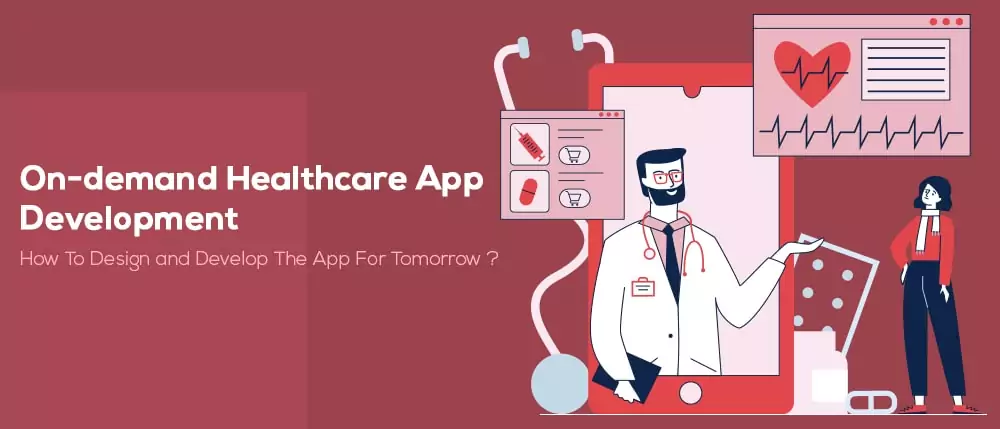
One of the best things to have happened in the last couple of years is the onset of on-demand healthcare. It would be hard to imagine a world without digital healthcare and harder to imagine one without on-demand healthcare during circumstances like the pandemic.
They were a blessing to a major chunk of the population. With several countries imposing strict lockdown restrictions and protocols, the only thing that helped us sail through the rough times were the on-demand services and especially, on-demand healthcare.
That’s why we felt it was really important for us to discuss more on this topic and present you all the information you need to know about the on-demand healthcare ecosystem, how it works, its benefits and what you could do to get an on-demand app or a website developed for your healthcare idea.
If this seems too sudden, we recommend you visit our previous blog on our Digital Transformation in Healthcare series, where we discussed the introduction of on-demand healthcare, how organizations see them, how you could systematically bring in such business models and more.
And if you’ve been following us every week, it’s time to get started with today’s topic – the ultimate guide to understanding on-demand healthcare apps.
How Does An On-demand Healthcare App Work?
To give you a quick picture, let’s brush through the basics. An on-demand app is where consumers get to choose their services and specify how they want, when they want and where they want. Just like how you could call an Uber from where you are and get dropped where you want to, services in the on-demand economy work in a similar way.

You have Netflix to demand your preferred movie, Spotify to listen to your favourite songs and the likes.
When it comes to healthcare, this involves you demanding healthcare services the way you want and the time you want. You could have a doctor’s consultation on demand, get medicines and medications dropped to your doorstep whenever you want, explore personalized insurance policies and select one of your choice or get a tailored plan on demand and more.
The entire purpose of on-demand healthcare is to make vague services like healthcare into decentralized, organized and extremely personal packages.
For this to happen, the chain has to involve several layers and processes. For a typical on-demand service to be airtight, it requires the following (but not limited to):
- A user, who is the very reason why an on-demand app or a service exists in the first place
- An on-demand app or a website, which is the aggregator or a marketplace that cumulates a number of service providers in one place for users to choose from
- Service providers, or vendors in general, who sign up with the portals to increase sales and make way for consistent streams of revenue and deliver their services
- And a tech infrastructure, which is powered by the most trending and advanced concepts like artificial intelligence, machine learning and others to keep the services as personalized as possible.
The Process
- The launching of an on-demand healthcare app is almost the last stage in the process of service delivery. It starts with the ideation and validation stages, where the need and market requirement for such a product is assessed. When the idea is validated, the product goes into the development process with the help of skilled app developers.
- Based on company requirements and budgets, they could either get a native or a hybrid app developed. When the app is partially ready and stable, the business development wing of the company gets started with pitching the service to vendors or service providers to get them onboard.
- The vendors or service providers on board immensely influence the standing of the app in the market in future as it would decide if users would be willing to use the service. This coupled with the brand’s popularity and market presence determine how quick the app gets its visibility.
- When the onboarding processes are done, the app is finally tested and launched in the market.
- Marketing and promotions happen in full swing. Marketing the apps is a different ball game altogether and campaigns are brainstormed according to the app’s niche.
- When users get to know about the app, they download it.
- If the on-demand healthcare app is about finding ortho specialists in vicinity, users would sign up on the platform and use their location for most appropriate results.
- The algorithms running at the backend do their job of throwing search results and optimizing them every single time.
- From the list of specialists available in vicinity, users select one based on a number of criteria such as the specialist’s credibility, customer reviews, pricing, open hours and more.
- The app’s UX allows users to immediately fix an appointment with the specialist. Now this appointment could be virtual or physical.
- Once it’s fixed, an email and an accompanying push message confirming the appointment is received by the user.
- Similarly, the specialist also receives the appointment details and modifies their calendar accordingly.
- The patient care process begins.
- If the on-demand healthcare app is a pharma app or a health insurance app, once the medications or policies are selected, users are taken to the payment gateway, where they could use a payment mode of their choice.
- They receive their orders and order confirmations when the payment is successful.
The entire process is triggered again on the next request.
The Advantages of On-demand Healthcare Apps
Now, from the business and operational model, it’s clear that the entire process is hassle free. There are no complications involved and what users see is what they get. No waiting. No hidden charges. No differences in service deliveries and more.
And on-demand apps have also been known for their conflict resolutions and super-tight customer service, which has made them all the more reliable by users. But these are not just the advantages on-demand healthcare apps offer.
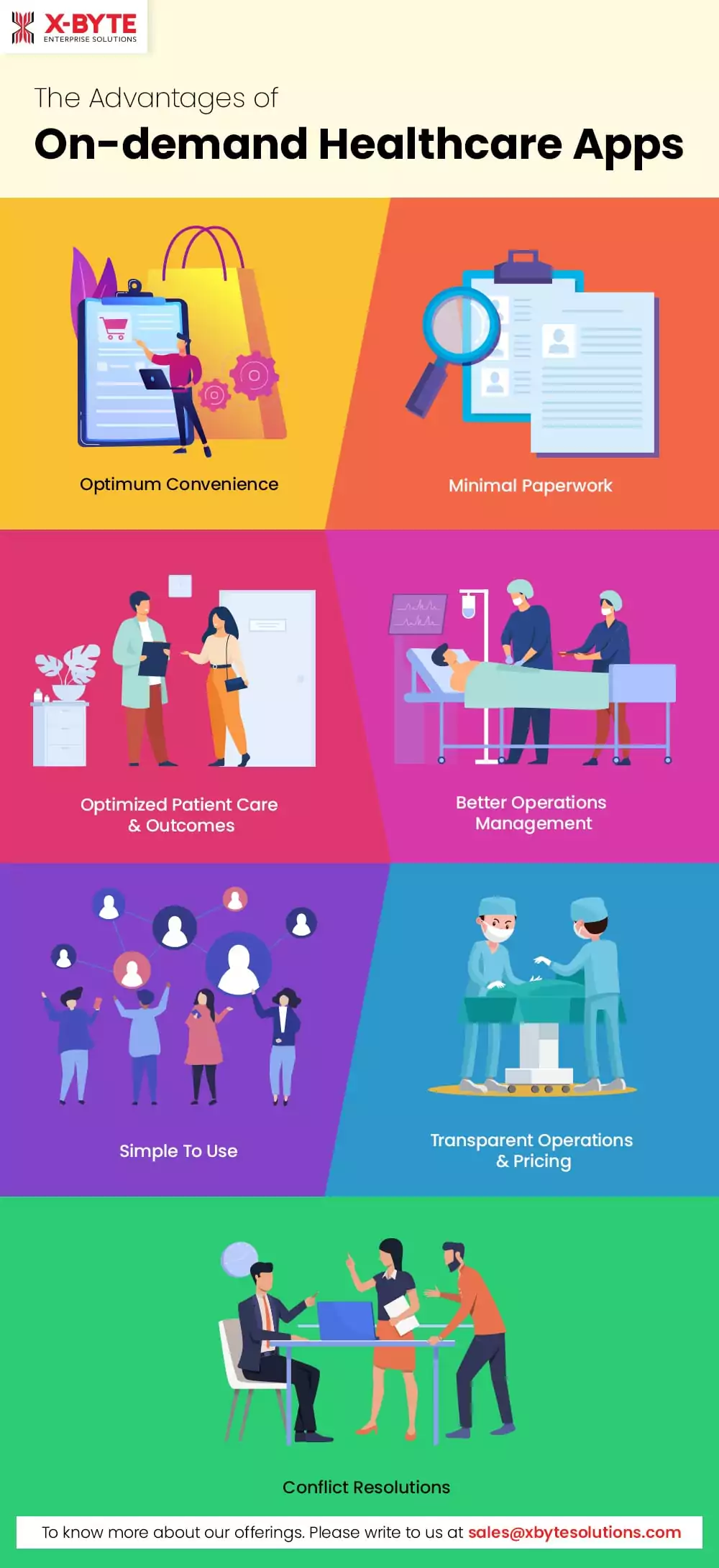
There are more than what meets the eye. Let’s explore them in detail.
Optimum Convenience
Imagine if you had an elderly person in your home. Or, if the patient was too sick to be taken to a hospital. In such cases, on-demand healthcare apps are the most ideal solutions to treat the patients as they could connect them to the most specialised doctor or physician for the ailment virtually or a doctor can be called home for personal diagnosis and treatments. This model completely eliminates the need for patients to fill forms, stand in line, wait in queues for their turn and more.
Minimal Paperwork
If you think, healthcare services are full of redundant tasks involving paperwork. From the time you enter a clinic to when you have to pay bills, there is tons of paperwork involved. But with on-demand healthcare, everything’s digital and there’s little to no paperwork. All your invoices and bills are sent via email, your health reports and details are accessed and retrieved from your electronic health records, your files are updated and stored on the cloud, prescriptions are electronic and more. This only adds to the convenience.
Optimized Patient Care and Outcomes
Since everything is digital, the procedures involved are also precise and accurate. Your electronic health records are updated and accurate, resulting in better and precise diagnosis. This in-turn improves the treatment provided in the evidence-based healthcare system. Because it’s digital, insurance claims are also processed swiftly as everything is properly documented. On-demand healthcare makes life easy for not just the patient but every stakeholder involved in the process.
Better Operations Management
Hospitals and clinics now have an efficient way to manage their operations and services. One look at the dashboard gives doctors, nurses and administrative staff a clear picture of how the day would be like in terms of patient footfall, staffing required and more. This helps in better supply-chain management, bed management, rostering of doctors and staff and more.
Simple To Use
Though on-demand services handle complex markets and concepts, they are very easy to use. They are designed by experts for laymen. The apps are super-basic and anyone (from the elderly to 10 year olds) can immediately start using services. The learning curve is minimal.
Transparent Operations and Pricing
Like we mentioned, on-demand healthcare is as transparent as it gets. When you book an appointment, you know which doctor or specialist you are about to meet and at what time. When you order medicines, you know from which pharmacy you’re getting it from. In the case of health insurance, you know the insurer. Accountability and transparency are at every stage of healthcare delivery processes. Plus, the prices are clear with no hidden agendas whatsoever.
Conflict Resolutions
On-demand Healthcare companies go an extra mile when it comes to addressing conflict resolutions. They understand that the economy is still in its nascent stages for people to completely get an understanding of things. That’s why they have separate customer service wings to take care of patient or consumer queries throughout the year. Some even go ahead and deploy advanced bots that can almost crack the Turing Test.
Factors To Consider While Investing In a Doctor On-demand App Development
Remember we mentioned on-demand healthcare app development? Well, the process is complex and time-consuming. For custom-built on-demand healthcare apps, the time to market is usually high because the demands and requirements are unlike anything prevailing in the market. A lot of testing and development goes into the picture before that one version of stable and reliable app gets rolled out.

So, if you’re someone who is considering investing in a doctor on-demand app and are wondering how you could go about it, here are some factors to get started with. These are curated from our years of experience in the app development domain and our interaction with our clients across the globe.
The App Type and Audience
The first step in getting a doctor on-demand app developed is to understand what type of app you intend to develop and for who. Is your app about generic healthcare services or is it going to be an aggregator of specialized sectors such as mental health, diabetes, ortho, neurology and more? Who is your target audience – patients or their caretakers? What does their demographics look like? Answering these will help you zero-in on your idea.
Service Providers Network
Your doctor on-demand app is all about getting the best service providers on board. By service providers, we mean reliable hospitals, clinics, physicians, diagnostic centres and more. Users need options to explore and choose from and when they have only limited options, they would abandon your apps. The wider your database, the seamless your customer acquisition process.
The Tech Stack
Not all on-demand healthcare apps come with the same requirement. And you cannot have a templated approach to developing one either. Every individual app requires its own set of tech stack distinct for its development.
Based on your requirements, React could be a better choice than Angular, a content management system could make more sense, voice search features, advanced concepts like virtual reality or augmented reality, machine learning and more. Sometimes, having a hybrid app could prove to be more efficient and cost-effective than native apps, too. Choose your tech stack based on your app’s requirements.
Compliances and Legalities
Since this is healthcare we are talking about, it has its fair share of formalities and compliances you should adhere to. There are procedures like HIPAA, FDA, HHS, HL7 and more to get started with. There are also other certifications, medical acts, GDPR requirements and more. You need to pay extra attention to this step.
All your ideas could either prove to be tomorrow’s next big thing or today’s disaster depending on who you collaborate with for your app development process. Before signing up, look at their
- Portfolio
- industry reputation
- similar projects they’ve indulged in and excelled
- their contract terms
- post-development services and maintenances
- pricing and plans
- tech stack
- cumulative work experience and more
To simplify this process, you could get in touch with pioneers in the industry like us to get started with your on-demand healthcare app development process.
Features of A Doctor On-demand App
On-demand apps are prominent because of the wide range of services and features they offer. We don’t think any other class of apps leverage the potential of a smartphone and its functionalities like on-demand apps do.
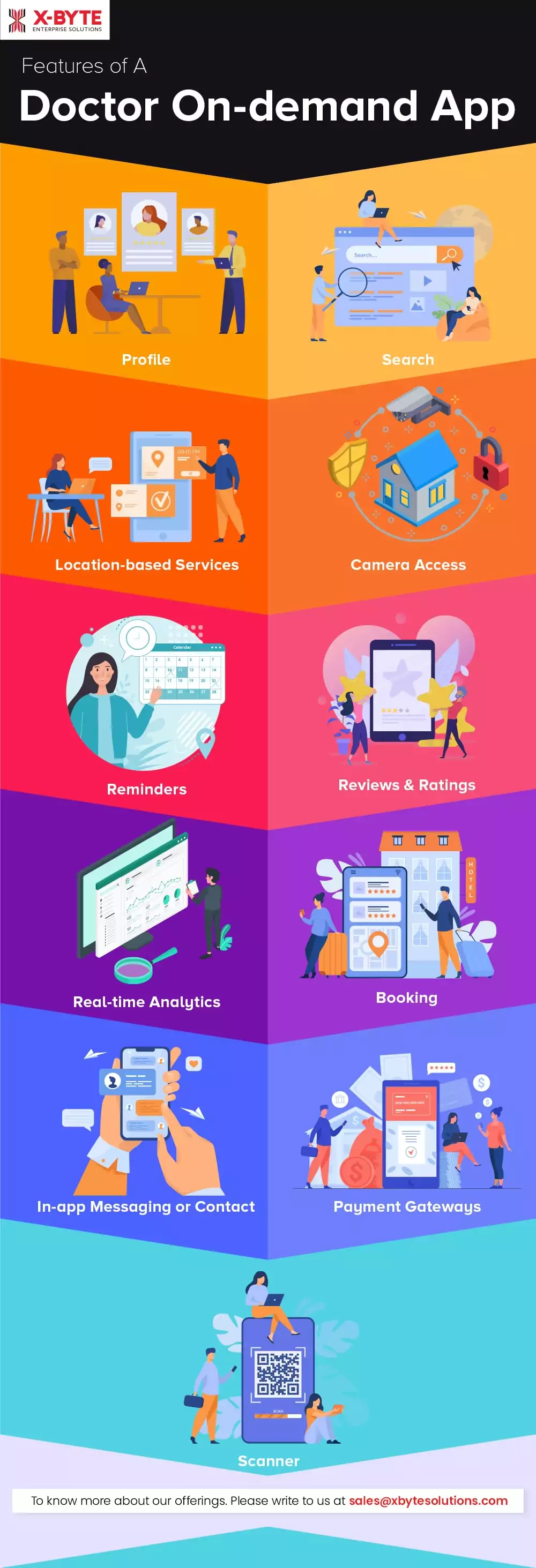
For a doctor on-demand app to be airtight and serve its purpose, a few features are inevitable. Let’s look at what they are.
Profile
The very backbone of all operations, this profile could be that of a user, a service provider, the app owner or an admin. The appearance and functionalities of all are different from one another and respective of their individual requirements.
Search
For users to look for their preferred services and clinics
Location-based Services
To look for services near them or enter a specific area for optimized search results
Camera Access
To connect with service providers virtually and for the verification of profiles
Reminders
Or push notifications for patients and users to know about their appointments, check ups and even medications
Reviews and Ratings
To make the platform more authentic and purposeful for other users
Real-time Analytics
To throw the most appropriate search results, understand users’ tastes, preferences and requirements and improve in terms of suggestions and recommendations
Booking
To make the necessary appointments in one click
In-app Messaging or Contact
To talk to experts, service providers or the support team of the app for all queries and questions
Payment Gateways
For seamless online payments through modes of their choice – wallets, credit cards, debit cards, internet banking and more
Scanner
To scan important documents like prescriptions and offline test results and upload them on the cloud for retrieval on the other side by doctors and stakeholders
Case Study
Top 3 Doctor On-demand Apps In The Market Currently
Doctor On Demand
One of the most popular apps in this niche, it has over 60,000 users rating it 4.9 stars on the App store and over 33,000 users rating it almost 5 stars on the Play Store. It offers instant and virtual connectivity with specialists like psychiatrists, psychologists, doctors and physicians and offers seamless pricing and plans. They have an impressive inventory of service providers on board with some of the most prominent doctors and specialists working with patients.
HealthTap
HealthTap is another prominent doctor on-demand app that allows you to have one-on-one consultations with qualified doctors and experts about your symptoms and health concerns. You could either go for individual sessions for an on-demand price or prefer a subscription-based plan and experience a wide range of benefits like 24/7 access to doctors, text chats, video consults and more.
HelloMD
Another stunner of an on-demand healthcare app is HelloMD that connects you with some of the top doctors and specialists in the niche. However, the only catch here is that it’s not an emergency care service. Meaning, you cannot get instant care but get appointments within 24 hours of booking. It curates and suggests you the best experts and lets you connect with them. This is most ideal for second opinions and consultations. It accepts multiple payment methods and is reliable in its offerings.
How To Select The Right Business And Revenue Models for A Doctor On-demand App?
Though healthcare is an excellent and noble niche to operate in, the entire purpose of setting up a business is to generate revenue. And as far as an on-demand healthcare app is concerned, there are tons of intricacies involved in investments and you need to come up with a proper revenue and business model to fetch returns and make profits.
This section of the guide will give you an idea on how you could monetize your app in more than one way and consistently reinvest in its promotions and tech upgrades to further push sales.
The Business Models
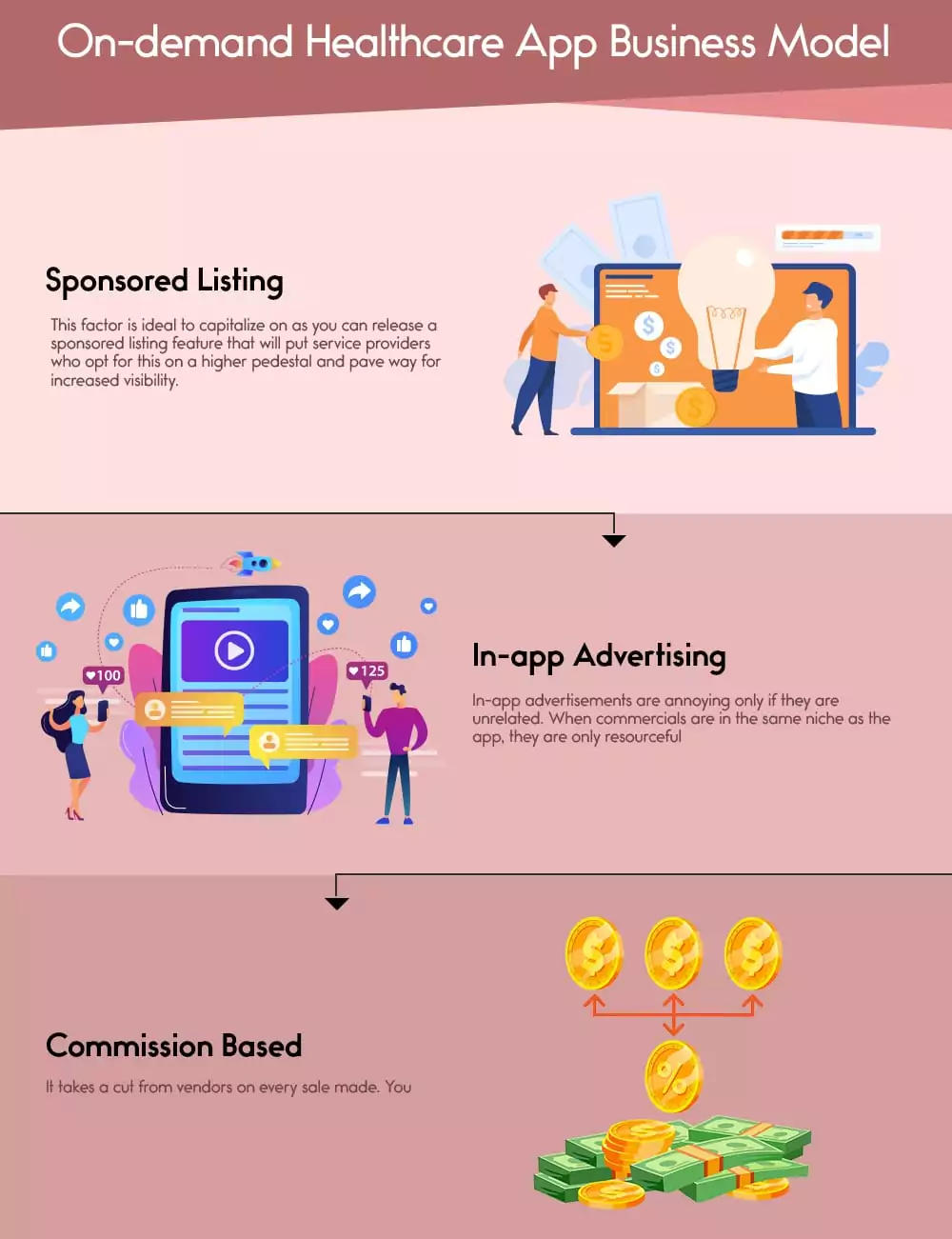
Sponsored Listing
Yours is primarily an on-demand marketplace, where multiple service providers would be vying for your users’ attention. This factor is ideal to capitalize on as you can release a sponsored listing feature that will put service providers who opt for this on a higher pedestal and pave way for increased visibility. This is usually on the first results and has a highlighted section to garner more attention. This way, the service providers could also experience increased footfall and get their RoI sorted.
In-app Advertising
In-app advertisements are annoying only if they are unrelated. When commercials are in the same niche as the app, they are only resourceful. For instance, an optometrist or an ophthalmologist advertisement showing up after an eye consultation would only solve the remaining problem to your user. Such targeted advertising can also be an avenue for you to generate revenue.
Commission Based
This is a popular business model partially made effective by Amazon. It takes a cut from vendors on every sale made. You could apply a similar logic and charge commissions for every service sought or appointment made through your portal.
Though these exist, one reason the on-demand economy was able to scale up swiftly was because of the innovation and experimentation it brought into its operating market. So, don’t restrict your business models to only these and coming up with interesting models that could be rewarding as well.
Technologies You Cannot Overlook For Your On-demand Healthcare App
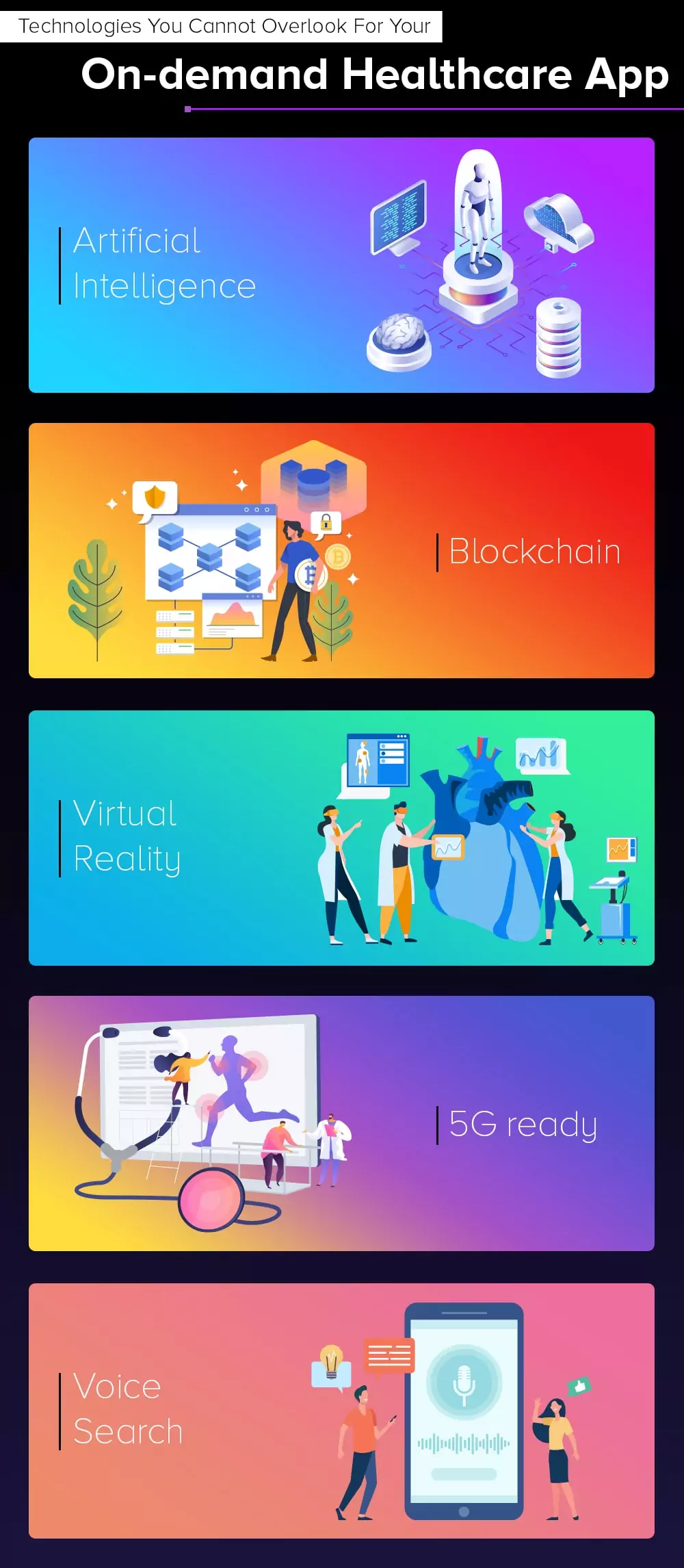
There are a lot of on-demand healthcare apps in the market today. If you remember from one of our previous posts, there are over 80,000 mobile health apps today. Yours needs to stand out from the clutter. And for this, your app needs to have a competitive edge which is only possible through the technologies you choose to incorporate for its functioning.
The tech implementation defines your app’s presence in the market and allows you to innovatively solve concerns. They also help to address minute details that add to the overall experience and satisfaction of your users.
But don’t worry. You don’t have to brainstorm on that as we have compiled the list of technologies you need to implement on your doctor on-demand app.
It is the fulcrum around which your app operates. It is ideal for recommendations, consumer analysis, adoption of new interests and preferences, real-time analytics, visualization of app usage and health monitoring and more. When we say artificial intelligence, we also include machine learning and deep learning algorithms.
Decentralized and devoid of an authority, this is the most ideal technology to fool-proof your app, its architecture and infrastructure. If you have confidential data such as personal health records, financial details, reports and more, blockchain is inevitable.
An underrated technology, this could be uniquely used to provide engagement to your users. This is used for educational purposes regarding your users’ health conditions, how medications react and more.
5G-Ready
It’s set up and ready to roll out. Your protocols, standards and functionalities must all be 5G-ready when it launches. The app can get a lot more done when it operates on the latest bandwidth and connectivity standards.
Voice Search
Over 50% of all searches are voice-based. Now, that’s a fact. With more smart assistants like Siri, Alexa and others becoming prominent in households, people would simply want to dictate searches. Your app must be ready to detect them and execute the necessary actions.
Wrapping Up
We believe this post was extensive and highly resourceful. All these could be too much to take in at one instance as well. But these are points you shouldn’t overlook when you’re planning to develop and launch your own doctor on-demand app.
But if you want to fast-forward to the point where you launch your app, we highly recommend getting in touch with us. We have years of experience developing on-demand healthcare apps. You could talk to us, check our portfolio, have a detailed discussion and get on board. We understand the healthcare spectrum like no other and this is evident through our write ups as well.
So, reach out to us today as the time is just ideal for launch of the next big on-demand healthcare app.